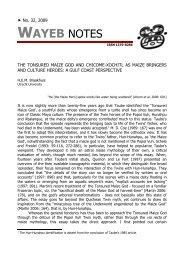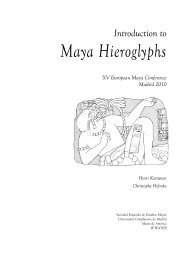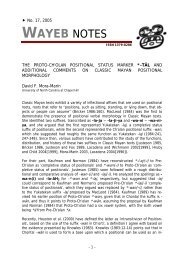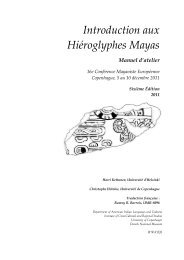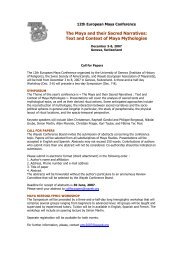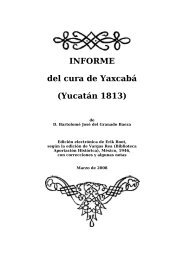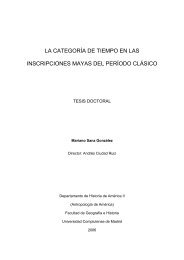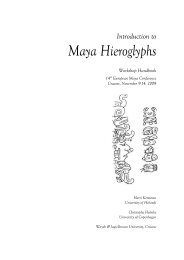Introduction to Maya Hieroglyphs - Wayeb
Introduction to Maya Hieroglyphs - Wayeb
Introduction to Maya Hieroglyphs - Wayeb
You also want an ePaper? Increase the reach of your titles
YUMPU automatically turns print PDFs into web optimized ePapers that Google loves.
Kettunen & Helmke 2011<br />
Glossary of Linguistic Terminology<br />
possessive<br />
A grammatical case indicating ownership or a relation comparable <strong>to</strong> ownership. Many <strong>Maya</strong> words (such as<br />
body parts and kinship terms) are INALIENABLY (innately) possessed and cannot stand alone (see the dictionary).<br />
See also PRONOUN.<br />
predicate<br />
A segment of a CLAUSE expressing something about the SUBJECT (excluding the subject,)<br />
prefix<br />
Generally a bound MORPHEME (or AFFIX) joined <strong>to</strong> a word on its left side (i.e. preceding the sign). In <strong>Maya</strong><br />
epigraphy prefixes indicate GRAPHEMIC signs attached <strong>to</strong> the viewer’s left of another sign.<br />
pronoun<br />
A word that can substitute for a NOUN or a noun phrase. Several types of pronouns are distinguished in<br />
grammars, including: personal pronouns (e.g. I, you, he, she), possessive pronouns (e.g. your, yours), demonstrative<br />
pronouns (e.g. this, that), interrogative pronouns (e.g. what, who), reflexive pronouns (e.g. myself, yourself), etc.<br />
Classic <strong>Maya</strong> pronouns indicate PERSON, but not GENDER. For example, the Classic <strong>Maya</strong> 3rd person singular<br />
ergative pronoun “u” can either mean “he”, “she”, or “it” (or “his”, “her”, “its”), and the gender can only be<br />
detected contextually. In the Classic <strong>Maya</strong> script there are three sets of pronouns: (1) personal pronouns, (2)<br />
POSSESSIVE pronouns, and rare occurrences of (3) demonstrative pronouns:<br />
personal and possessive pronouns:<br />
demonstrative pronouns:<br />
u<br />
u<br />
“he, she, it, his, her, its”<br />
(before consonants)<br />
ha-i<br />
ha’i’<br />
“that”<br />
ya 88<br />
y-<br />
“he, she, it, his, her, its”<br />
(before vowels)<br />
ha-o-ba<br />
ha’ob<br />
“those”<br />
Table XXV: Examples of Classic <strong>Maya</strong> pronouns in the hieroglyphic texts<br />
pro<strong>to</strong>-<br />
A prefixed word that suggests a supposed “ances<strong>to</strong>r” of related languages. For example, the ances<strong>to</strong>r of all the<br />
<strong>Maya</strong> languages is referred <strong>to</strong> as Pro<strong>to</strong>-<strong>Maya</strong>, and the immediate ances<strong>to</strong>r of Tzeltalan languages as Pro<strong>to</strong>-<br />
Tzeltalan. Comparative his<strong>to</strong>rical linguistics is a field engaged in determining what the pro<strong>to</strong>-forms of a given<br />
language family were by analyzing series of COGNATE words in attested languages. Reconstructed pro<strong>to</strong>-forms are<br />
marked with an asterisk (*) immediately before the word: e.g. *k’e’ŋ is a proposed Pro<strong>to</strong>-<strong>Maya</strong> form of the Classic<br />
<strong>Maya</strong> word ch’e’n (“cave”).<br />
root<br />
The base form of a word, which cannot be further analyzed without losing the word’s identity. In <strong>Maya</strong><br />
languages roots are monomorphemic STEMS that can either be free MORPHEMES (e.g. “sky”, “walk”, “you”) or<br />
bound morphemes (e.g. “in-”, “pre-”, “-ness”).<br />
88<br />
This is only one (graphemic) example of prevocalic personal and possessive pronouns (the ya-sign is used with words starting with the vowel<br />
/a/). Others are ye, yi, yo, and yu with corresponding initial vowels (/e/, /i/, /o/, and /u/, respectively).<br />
141/154



